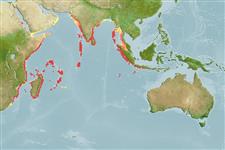>
Mulliformes (Goatfishes) >
Mullidae (Goatfishes)
Etymology: Parupeneus: Latin, parum, parvum = small + Peneus, the name of a river.
More on author: Lacepède.
Environment: milieu / climate zone / depth range / distribution range
Ekologi
marina revassocierade; djupintervall 0 - 80 m (Ref. 1602). Tropical; 24°N - 33°S, 28°E - 112°E
Indian Ocean: Oman and East Africa south to South Africa and east to Christmas Island and Java, Indonesia.
Included in the Parupeneus trifasciatus complex are: Parupeneus trifasciatus from the Indian Ocean; Parupeneus crassilabris from eastern Indian Ocean and the western Pacific, east to Fiji, Tonga, and the Caroline Islands; and Parupeneus insularis from the more eastern islands of Oceania.
Size / Vikt / Age
Maturity: Lm ? range ? - ? cm
Max length : 35.0 cm TL hane/ej könsbestämd; (Ref. 30573); common length : 27.0 cm TL hane/ej könsbestämd; (Ref. 30573); publicerad maxvikt: 656.00 g (Ref. 125599)
Taggstrålar i ryggfenan (totalt) : 8; Mjukstrålar i ryggfenan (totalt) : 9; Taggstrålar i analfenan: 1; Mjukstrålar i analfenan: 7.
This occasionally schooling species inhabits lagoon and seaward reefs: juveniles on reef flats, adults tend to occur around rocky or coralline areas of high vertical relief. Feeds on crustaceans at daytime and on fishes and crab larvae at night. Also feeds on worms (Ref. 6113). Occurs in 3 color forms. The Indian Ocean form has 2 sharply defined wedge-shaped bars become narrower and sometimes end on the belly. The Indo-Australian form has 3 very distinct dark patches and rows of yellow spots on the sides. The Pacific Plate form has 2 wide bars that extend to the belly (Ref. 37816). Minimum depth reported taken from Ref. 128797.
Life cycle and mating behavior
Könsmognad | Reproduktion | Lek | Ägg | Fecundity | Larver
Randall, J.E. and R.F. Myers, 2002. Parupeneus insularis, a new central pacific species of goatfish (Perciformes:Mullidae) of the P. trifasciatus complex. Zool. Stud. 41(4):431-440. (Ref. 45589)
IUCN Red List Status (Ref. 130435: Version 2024-1)
Threat to humans
Harmless
Human uses
Fiskeri: kommersiell
Verktyg
Special reports
Download XML
Internet-källor
Estimates based on models
Preferred temperature (Ref.
123201): 23.6 - 29, mean 27.8 °C (based on 1364 cells).
Phylogenetic diversity index (Ref.
82804): PD
50 = 0.5000 [Uniqueness, from 0.5 = low to 2.0 = high].
Bayesian length-weight: a=0.00813 (0.00536 - 0.01232), b=3.18 (3.06 - 3.30), in cm total length, based on LWR estimates for this species & Genus-body shape (Ref.
93245).
Trofisk nivå (Ref.
69278): 3.5 ±0.50 se; based on food items.
Resiliens (Ref.
120179): Mellan, lägsta populationsfördubblingstid 1,4-4,4 år (Preliminary K or Fecundity.).
Fishing Vulnerability (Ref.
59153): Low vulnerability (25 of 100).
Nutrients (Ref.
124155): Calcium = 33.2 [16.8, 74.0] mg/100g; Iron = 0.307 [0.155, 0.679] mg/100g; Protein = 17.9 [14.5, 20.9] %; Omega3 = 0.128 [0.073, 0.231] g/100g; Selenium = 56 [27, 128] μg/100g; VitaminA = 195 [39, 810] μg/100g; Zinc = 0.531 [0.319, 1.009] mg/100g (wet weight); based on
nutrient studies.
